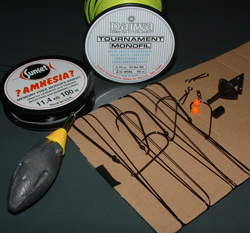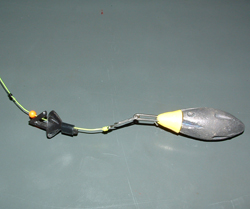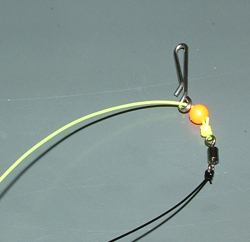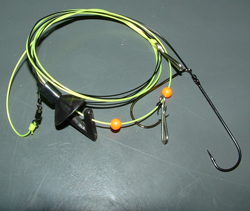
East Anglia Sea Angling
My own thoughts on my fishing and related exploits in 'Bootiful' East Anglia
Pulley Pennel |
||
1. Components 2. Detail of the lead end showing the stop knot, bead, impact shield and lead. Don't use expensive impact leads if you're using this rig over rough ground. 3. The leader end details. The clip attaches the rig to your leader swivel. The important thing to ensure is that the rig body is going to take the force of the cast and not the hook length. 4. The finished pulley, it'll probably sit in my rig wallet until I go to the Lleyn or Devon. |
|
|
The classic snaggy/rough ground beating rig, though I really struggle to think of a venue to use it around my stretch of coast. Possibly Weybourne under the cliffs among the flints and marl, even then I think I'd tend to go for a regular fixed paternoster like a pennel. These rigs are used almost exclusively in the Southwest, Wales and anywhere else where you're fishing over reefs and rocks, even then they rely on fish to pull the lead out of the way of the snags. I've never managed to cast it as far as I can a simple clipped down pennel or single hook arrangement. You can use a single hook if you prefer, but if you're fishing with big baits I think the pennel arrangement takes some beating presentation wise.
Outside of the scenarios above I really don't see the benefit of using these rigs over clean ground. 90 odd percent of my fishing is done over shallow, clean sand with a fairly strong lateral tide. I don't think those conditions are ideal for running ledger type rigs personally, which is what the pulley set up is in effect. I want the fish to move the lead when it bites, hopefully hooking itself in the process. The times I have used this rig I have had some positive bites that haven't resulted in hooked fish, I think this is down to the fact they can move the rod without moving the lead, or worse still both of them together. With a fixed paternoster set up the fish moves the lead first which in turn moves the rod nearly always resulting in a classic slack line bite and no need to strike. I know the rig does work well and I'm open to education on how to tie it and/or use it, I feel I'm missing something with it, feel free to email me and let me know what I'm missing.
It's pretty obvious this rig can be a killer if you're fishing into rocks or reef, but try as I might, I can't see the benefit on flat clean, sandy beaches. Horses for courses it is, but until someone educates me differently it's not a rig that I'll be using in Norfolk.
|
||



